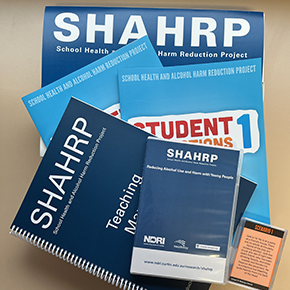 The SHAHRP intervention is comprised of 13 harm minimisation classroom lessons, over a two-year period. The SHAHRP lessons assist young people by enhancing their ability to identify and use strategies that will reduce the potential for harm in drinking situations and that will assist in reducing the impact of harm once it has occurred.
The SHAHRP intervention is comprised of 13 harm minimisation classroom lessons, over a two-year period. The SHAHRP lessons assist young people by enhancing their ability to identify and use strategies that will reduce the potential for harm in drinking situations and that will assist in reducing the impact of harm once it has occurred.
Teacher training
Teacher training is ideally conducted before each phase of the SHAHRP intervention. During Phase One, teachers are provided with two days of training that provides an overview of the study behaviour outcomes, evidence-based components, and interactive modelling of each Phase One activity. Phase Two training is conducted over two days for teachers new to SHAHRP. On the first day of training, these teachers are briefed on the research aspects of SHAHRP and Phase One intervention activities. On day two, all teachers participate in interactive modelling of Phase Two activities. Teachers who are experienced in interactive techniques are recommended as SHAHRP teachers.
Teacher manual
The SHAHRP Teacher Manual provides specific written guidance for teachers. The manual included detailed and structured lesson plans for eight 60-minute lessons in the First Phase and five 50-minute lessons in the Second Phase. Each lesson plan includes sample questions to help facilitate discussion and processing of activities and to focus on activity intention, coaching points to aid in the management of the activities, and background information about alcohol-related issues. Additional coaching points have been included in the teacher manual and are based on feedback from teachers who have previously taught the program.
Student workbooks
The SHAHRP program is largely activity based, however, student workbooks are available for each phase to stimulate and engage students’ interest, provide information, encourage young people to further explore issues and to record what they have learned to consolidate practical activities. Qualitative results from the SHAHRP study show that young people and teachers think the books are appealing and great to use as reinforcement to the interactive activities.
Trigger Visual
A Trigger Visual is used in Phase Two of SHAHRP. The video features scenarios that young people may experience in alcohol use situations to prompt discussion about how to minimise the harms associated with alcohol use.
The SHAHRP Intervention Components may be downloaded from the Resources page.
Skills basis
The SHAHRP activities incorporate various strategies for interaction including delivery of utility information; skill rehearsal; individual and small group decision making; and discussions based on scenarios suggested by young people, with an emphasis on identifying alcohol-related harm and strategies to reduce harm. Interactive involvement is emphasized, with two-thirds of activities being primarily interactive and another 15% requiring some interaction between young people. Interactive involvement between young people provides important practice in reducing harm associated with alcohol use that is relevant and acceptable to young people, and this is a critical aspect of lessons using an evidence-based approach.
Ages for delivery
The SHAHRP Randomised Controlled Trial indicates that implementation should be based on local prevalence data. Phase One of SHAHRP is designed to be implemented in the year prior to prevalence data indicating that experimentation has started to occur. Phase Two of SHAHRP is designed to be implemented when the prevalence data indicates that young people are starting to experiment with alcohol. In Australia, prevalence data has been consistent overtime and indicates that implementation should occur in year eight (12/13 year’s old) and year nine (13/14 year’s old) of secondary school.
Dose and fidelity of implementation
To maximise effectiveness when using the SHAHRP program, it is important to teach the program as closely as possible to how it is documented in the teacher manual. The student behaviour changes that came during the SHAHRP Randomised Controlled Trial were based on teaching the program to at least 80% as documented. During the SHAHRP Randomised Controlled Trial study teachers also received training in the delivery of the program to students. Two days of training were conducted for Phase One of the SHAHRP program, and one day of training for Phase Two (two days for those new to SHAHRP). The training involved an overview of the research background and program development. In addition, teachers participated in each activity to model how the activity should be taught and allowed teachers to assess implementation and management requirements.